House prices are rising strongly in Slovak Republic
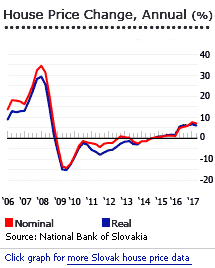 House prices in Slovakia are now rising strongly, with demand buoyed by low interest rates. The average residential property price rose by 7.04% to €1,369 (US$1,437) per square metre (sq. m.) during the year to Q2 2017, an acceleration from last year's 4.75% y-o-y rise, according to the National Bank of Slovakia (NBS). When adjusted for inflation, property prices rose by 6.02%. During the latest quarter, property prices rose by 2.78% (2.4% in real terms).
House prices in Slovakia are now rising strongly, with demand buoyed by low interest rates. The average residential property price rose by 7.04% to €1,369 (US$1,437) per square metre (sq. m.) during the year to Q2 2017, an acceleration from last year's 4.75% y-o-y rise, according to the National Bank of Slovakia (NBS). When adjusted for inflation, property prices rose by 6.02%. During the latest quarter, property prices rose by 2.78% (2.4% in real terms).
Despite this, Slovakia's house prices are still 11.6% below their Q2 2008 peak (-21.6% in real terms).
In Bratislava region, which has the country's most expensive housing, residential property prices rose by 6.7% y-o-y to €1,904 (US$2,283) per sq. m. during the year to Q2 2017, up from y-o-y rises of 6.3% a year earlier and 2.6% in Q2 2015.
All the other regions also saw strong house price increases during the year to Q2 2017.
- Trencin experienced the biggest rise of about 15.9% y-o-y to €744 (US$892) per sq. m.
- In Nitra, house prices surged 15% y-o-y to €668 (US$801) per sq. m.
- In Presov, house prices rose by 10.3% y-o-y to €838 (US$1,005) per sq. m.
- In Trnava, house prices rose by 9% y-o-y to €937 (US$1,124) per sq. m.
- In Kosice, house prices increased 7.4% to €990 (US$1,187) per sq. m. over the same period
- In Zilina, house prices rose by 5.7% y-o-y to €866 (US$1,038) per sq. m.
- In BanskaBystrica, house prices increased 4.6% y-o-y to €768 (US$921) per sq. m.
AVERAGE RESIDENTIAL PROPERTY PRICES |
|||||
| HOUSE PRICE BOOM (Q1 2005-Q4 2008) | GLOBAL FINANCIAL CRISIS, EUROZONE DEBT CRISIS (Q1 2009-Q4 2015) | 2016
(Y-O-Y CHANGE) |
Q2 2017 (Y-O-Y CHANGE) | EUR/SQ. M
(Q2 2017) |
|
| SLOVAKIA | 78.19 | -12.81 | 5.8 | 7.0 | 1,369 |
| REGIONS | |||||
| Bratislava | 70.69 | -6.13 | 6.8 | 6.7 | 1,904 |
| Trnava | 65.23 | -15.83 | 5.7 | 9.0 | 937 |
| Nitra | 111.08 | -29.40 | 15.8 | 15.0 | 668 |
| Trencin | 177.00 | -22.13 | 5.2 | 15.9 | 744 |
| Zilina | 122.97 | -17.13 | 11.3 | 5.7 | 866 |
| BanskaBystrica | 124.67 | -14.06 | -1.1 | 4.6 | 768 |
| Kosice | 118.11 | -3.44 | 2.6 | 7.4 | 990 |
| Presov | 77.76 | -22.15 | 6.8 | 10.3 | 838 |
| Source: National Bank of Slovakia | |||||
The housing boom in Slovakia lasted from 2006 to Q2 2008, with house price rises ranging from 14% to 35% per annum. The surge stopped in late 2008, and prices either fell or only increased a little in following years.
- In 2009, house prices fell by 12.31% (-12.66% in real terms)
- In 2010, house prices fell by 2.08% (-3.16% in real terms)
- In 2011, house prices fell by 2.68% (-6.86% in real terms)
- In 2012, house prices increased by 0.89%, but in fact fell by 2.55% when adjusted for inflation
- In 2013, house prices fell by 2.57% (-3.01% in real terms)
- In 2014,house prices increased by a meagre 0.25% (0.25% in real terms)
- In 2015, house prices rose by 1.15% (1.62% in real terms)
- In 2016, the housing market started to grow stronger, with house prices rising by 5.84% (6% in real terms) from a year earlier
Slovakian house prices are expected to continue rising during the remainder of this year and until 2018, amidst a continued surge in property demand both from local homebuyers and foreign investors, according to local property experts.
Slovakia registered economic growth of 3.3% in 2016, from real GDP growth rates of 3.8% in 2015, 2.6% in 2014, 1.5% in 2013, 1.7% in 2012, and 2.8% in 2011. The Slovakian economy is projected to expand by 3.3% this year and by another 3.7% in 2018, according to the IMF.
There are no legal restrictions on foreigners buying buildings in Slovakia.
Flat prices are surging

Flats registered the biggest house price gains nationally, surging by 9.4% y-o-y in Q2 2017 to an average price of €1,590 (US$1,907) per sq. m, according to the NBS.
- 1-room: prices soared 10.5% to €1,749 (US$2,097) per sq. m during the year to Q2 2017
- 2-room: prices rose by 11.5% to €1,683 (US$2,018) per sq. m during the year to Q2 2017
- 3-room: prices rose by 8.8% to €1,506 (US$1,806) per sq. m over the same period
- 4-room: prices rose by 6.3% y-o-y to €1,482 (US$1,777) per sq. m in Q2 2017
- 5-room: prices rose by 6% y-o-y to €1,636 (US$1,962) per sq. m in Q2 2017
Houses increased in value by just 3.4% to €1,139 (US$1,366) per sq. m. during the year to Q2 2017.
Residential construction back at pre-crisis levels
Residential construction activity continues to rise. In 2016, the number of housing starts stood at 21,440 units, up 9.2% from a year earlier and the highest level since 2008, according to the European Central Bank (ECB). Housing starts averaged 19,700 units from 2003 to 2009, which means that activity is now back at pre-crisis levels.
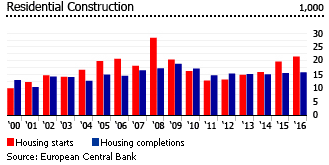
Likewise, housing completions rose by 1.3% to 15,670 units in 2016 from a year earlier - at par with the average yearly completions of 15,500 units from 2003 to 2009.
Low interest rates are boosting property demand
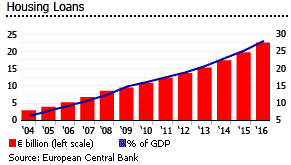
Mortgage loan growth has been 12.9% annually from 2009 to 2016, with volumes rising from €9.5 billion (US$11.4 billion) in 2009 to €22.5 billion (US$27 billion) in 2016. During the boom years, the volume of housing loans to households rose by a spectacular 30.8% annually from 2005 to 2008, mainly due to very low mortgage interest rates.
The average interest rate on housing loans stood at 1.83% in May 2017, from 1.79% in May 2016, 2.77% in May 2015, and 3.44% in May 2014, according to the NBS.
In May 2017:
- Average floating rate loan interest rate, or loans with interest rate fixation (IRF) of up to 1 year: 2.2%, up from 1.75% a year earlier but still down from 3.68% two years ago
- IRF over 1 to 5 years: 1.68%, unchanged from a year earlier but down from 2.49% two years ago
- IRF over 5 to 10 years: 3.33%, up from 2.47% a year earlier but down from 5.19% in May 2015
- IRF of over 10 years: 1.6%, down from 2% a year earlier and 5.21% two years ago

The persistently low interest rates environment in Slovakia is due to the ECB cutting its key rate eight times since November 2011 to a historic low of 0.00% in March 2016, where it remained since.
Yet these cuts have had less effect than might be expected, as banks have become very cautious. Slovakia still has one of the lowest mortgage-debt-to-GDP ratios in the EU, at 27.8% of GDP in 2016, less than half of the EU 28's ratio of about 50%.
In June 2017, the total outstanding amount of housing loans to households rose by 14.2% to almost €24 billion (US$28.7 billion) from the same period last year, according to the NBS.
Rental market is very limited
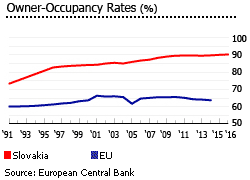
Bratislava appears to be an attractive location to own properties but anecdotally, properties can be quite hard to let. Bratislava is a small place, and few people absolutely need to live in the centre of town unlike the larger capitals of other countries where commuting times can be inconveniently high. Because Slovakia itself is small, the number of expatriates, embassies, and international companies in Bratislava is small, which again restricts the supply of tenants.
Owner-occupancy in Slovakia has risen sharply from about 50% during the 1980s to 90.1% in 2016, making Slovakia the country with the third highest homeownership rate in the EU, way past the EU average of less than 70%. Tenants were only around 9.7% of Slovakia's population, according to Eurostat.
But only 0.1% of Slovakia's housing stock is let out by private landlords, mainly in Bratislava.
The growth of owner-occupation is partly due to a contractual savings system (Bauspar) that makes it easy for Slovaks to obtain housing loans. This Bauspar system allows borrowers to take loans at lower interest rates, with the government paying an interest premium on the amount saved.
In 2005, the government decreed the abolition of rent control, effective July 1, 2007. However, the decree was never implemented. Rent deregulation has been postponed repeatedly, as Parliament refuses to deal with this highly sensitive issue.
Yields are moderately good; rents are still low
According to the Global Property Guide research conducted in July 2017, in Stare Mesto, Bratislava's city centre:
- Gross rental yields on 50 sq. m. apartments were around 5.25%.
- Larger units of around 120 sq. m. had slightly lower yields of 4.47%.
- The average yield in Stare Mesto fell slightly to around 4.5% this year, from 5% in 2016 and 5.53% three years ago.
In the Bratislava's less upscale districts of Ruzinov and NoveMesto (Bratislava II and III), gross rental yields were not much different, between 4.6% to 5.35%. The Airbnbmarket is thriving, but expect damage to your property.
Rents range from around €11.5 (US$13.8) to €12.5 (US$15) per sq. m. per month in the Old Town of Bratislava, whereas in the nearby areas of Ruzinov and in the New Town, rents range from €8.8 (US$10.6) to €10.6 (US$12.7) per sq. m. per month.
Round trip transaction costs are very low on residential property in Slovakia.
Healthy economic growth; falling unemployment
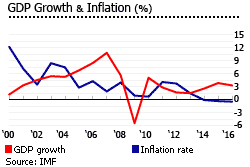
Slovakia is one of Eastern Europe's most successful transition countries. Born in 1993 after seceding amicably from the Czech Republic (the two countries were formerly known as Czechoslovakia), it has a stable polity and liberal market economy. Slovakia benefited from eight years' reform under the centre-right coalition led by MikulasDzurinda (1998-2004) whose reforms won praise from international organizations, and who oversaw EU and Nato entry.
The economy's rapid growth facilitated the country's membership of the Organization for Economic Cooperation and Development (OECD) and the European Union (EU) in 2004. In December 2007 Slovakia became a full member of the Schengen Zone, allowing passport-free travel in the 24-member European nations.
Real GDP growth reached an impressive 10.8% in 2007, following 8.5% for 2006, 6.8% for 2005, and 5.3% for 2004. Kia, Volkswagen, and Peugeot Citroen all have built large car plants in Slovakia.
Since then, Slovakia has had two terms under the socialist and populist leader Robert Fico, of the Smer party (prime minister 2006-2010, and 2012 to present).
Fico's stewardship has been marked by tension with Hungary, populism towards Slovakia's Roma population, and weaker economic growth.
In 2008 there was 5.6% growth, and then a collapse with the crisis and a 5.4% GDP contraction in 2009. Slovakia's economy recovered quickly with GDP growth of 5% in 2010, but this was followed by 4 weak years, with 2.8% GDP growth in 2011, 1.7% in 2012, 1.5% in 2013 and 2.6% in 2014. In the past two years, the economy bounced back somehow, recording a 3.8% expansion in 2015 and another 3.3% in 2016. The Slovakian economy is projected to expand by 3.3% this year and by another 3.7% in 2018, according to the IMF.
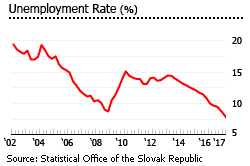
In 2016, the central government budget deficit stood at €980 million (US$1.18 billion), down by almost half from a year ago and the lowest deficit in the past eight years, according to the Ministry of Finance of the Slovak Republic. As percent of GDP, the budget deficit fell to just 1.68%, down from 3% in 2015 and 2.7% in 2014.
In the government's three-year fiscal plan, the country is expected to record its first budget surplus of 0.16% of GDP in 2019. Slovakia's gross public debt will fall slightly to 51.5% of GDP this year and to 49.8% of GDP next year, from 51.9% in 2016 and 52.5% in 2015, according to the European Commission.
The country had an annual inflation rate of 1% in June 2017, up from -0.8% in the same period last year, according to the Statistical Office of the Slovak Republic. Consumer prices are expected to increase by 1.4% this year, after falling by 0.5% in 2016, 0.3% in 2015 and 0.1% in 2014, according to the European Commission.
In June 2017, nationwide unemployment fell to 6.9%, from 7.4% in May, 7.7% in April, and 8% in March 2017, according to the central bank. The IMF expects the unemployment rate to fall to 7.9% this year, from 9.7% in 2016 and an annual average of 13.3% from 2009 to 2015.
"We have the lowest deficit ever, the lowest debt in five years. We're pleased about the developments on the labour market, and we also have the lowest unemployment rate ever. None of that can be taken for granted. The results are better than we expected," said Slovak Finance Minister Peter Kazimir.